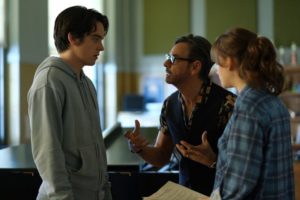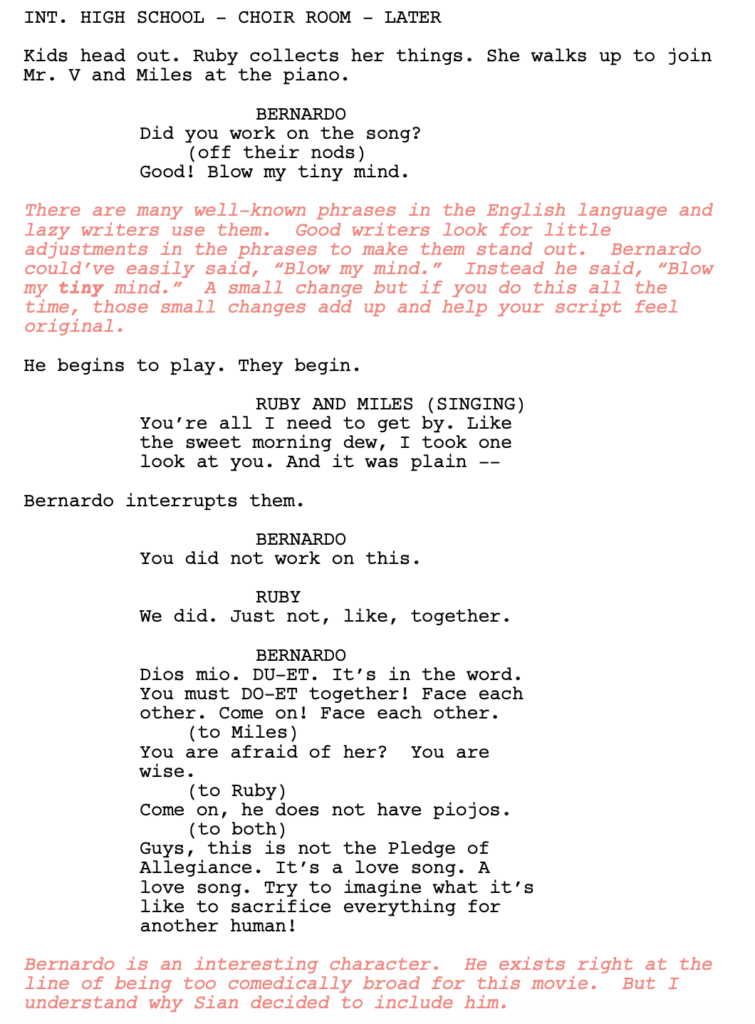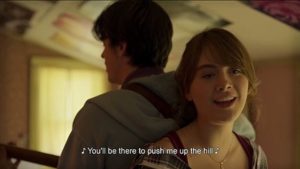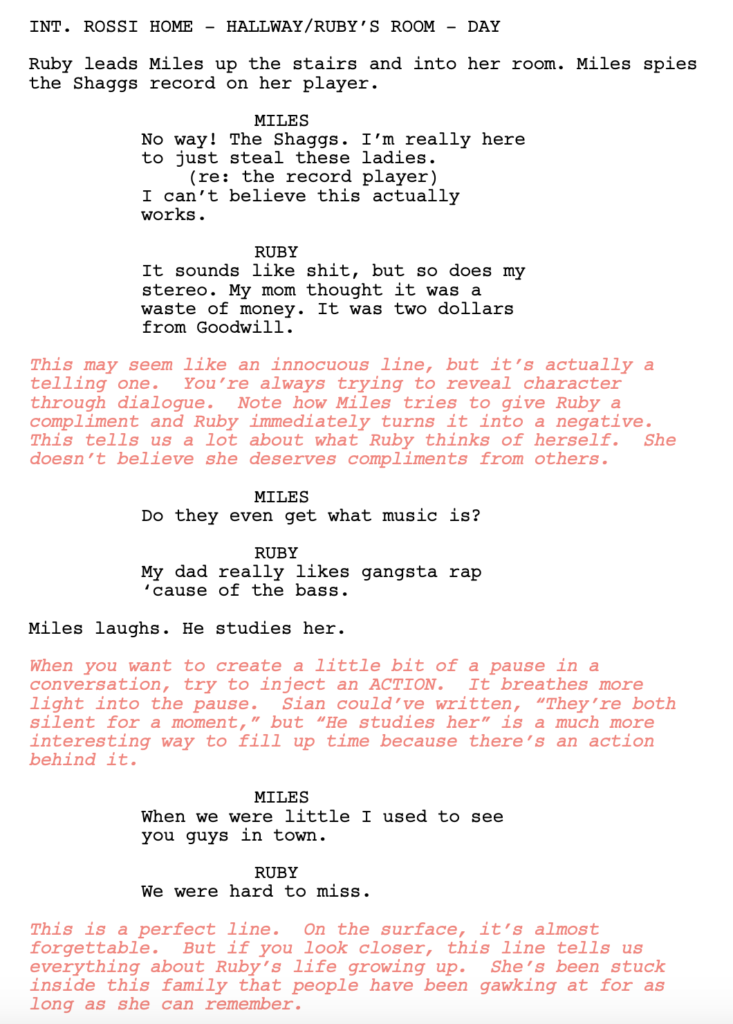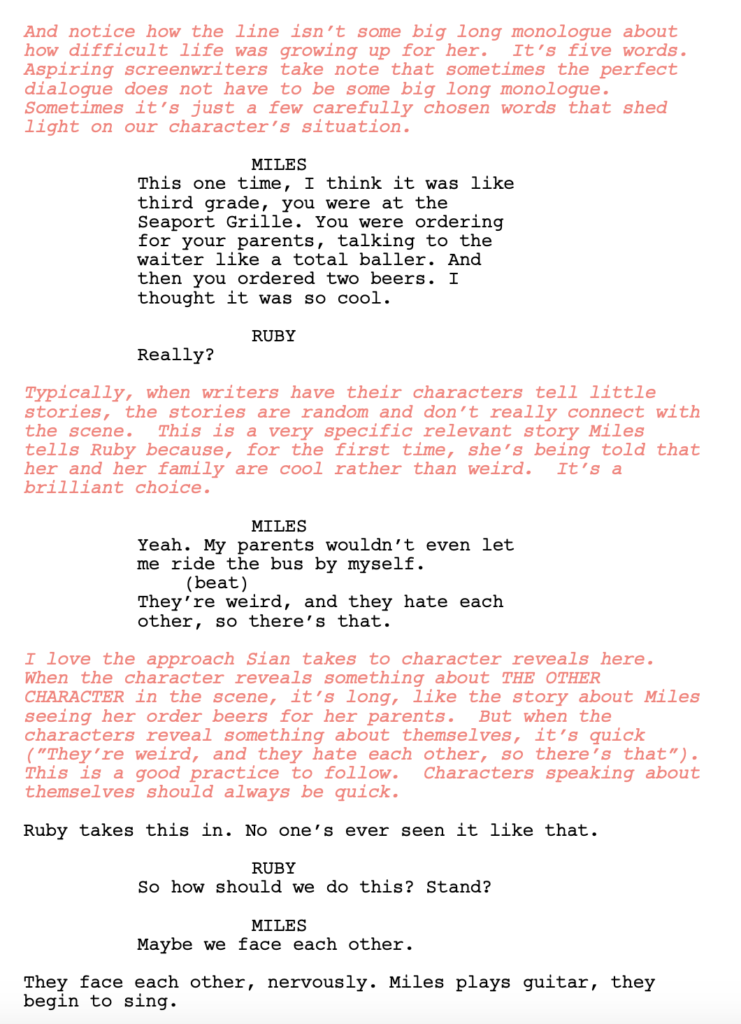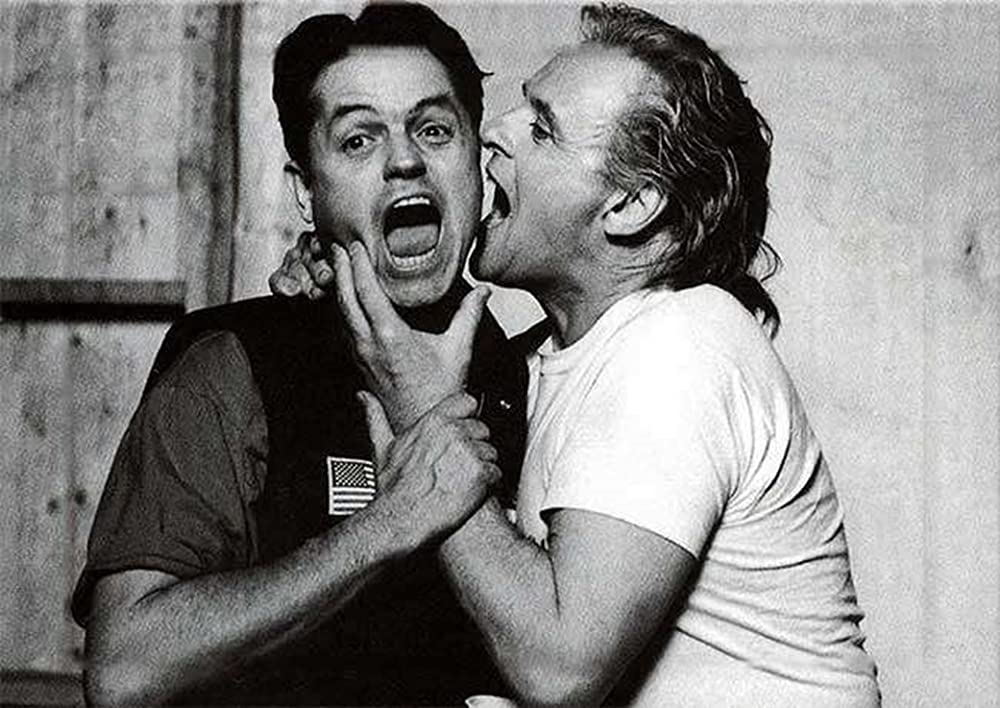
Something has been happening frequently enough in the amateur consultation scripts I’ve been reading lately that I need to bring it up. Because if it’s happening in five of the last seven scripts I read, it’s happening everywhere.
I’m talking about OFF-SCREEN STORY. Off-screen story is any story that occurs outside the pages of your screenplay. A traumatic moment that your adult main character experienced when he was seven – that’s off-screen story. Unless you flash back and show it to us, of course.
But off-screen story can also be something simple. If you show us your hero eating dinner with his family and then the next scene is him at work the following day, well, there’s a good 12 hours of off-screen story that occurred between those two scenes.
Your character STILL EXISTS in those moments. Stuff happened in his life. Maybe his youngest son got picked on at school and he had to give him a little speech to make him feel better. Maybe he needed to help his teenaged daughter with algebra homework. Maybe he got in a small fight with his wife about a friend’s wedding she wanted him to come to but he doesn’t want to go.
And by the way, there are additional off-screen stories going on with your secondary characters. Just because the hero’s wife only appears in four scenes, that doesn’t mean she didn’t have things to do and places to go while we were following your main character.
What I’ve found is that the more a writer knows about their off-screen story, the better the script is. This skill really does belong to a small percentage of writers – and they tend to be the advanced ones.
It makes sense when you think about it. Beginner and intermediate screenwriters are still learning the basics, like character arcs, and conflict, and how to create suspense, and how to pace their story out. Having to worry about things that don’t even happen on the page is the last of their concerns.
And yet, it is the thing that will take your screenwriting to the next level.
Here’s why.
The more you know about the world you’re writing in, the more confident your writing will be. It’s no different from real life. The more you know about a topic, the more confident you’ll be talking about it. Whenever you know more about your characters and the world they exist in, the more confidently you will write. And I’m going to prove it to you.
Write a 3-scene story about a guy who works at a telephone company. Doesn’t matter what the story is. Just write it. When you’re finished, write a 3-scene story with you as the main character that takes place at your own place of work.
I bet you the second scene is going to be a lot more specific, a lot more authentic, and populated with a lot more detail. Why? Well first of all, you know everything about yourself because you’re you. So you know what kind of mood you were in last night, all the obstacles you’ve experienced the past week. You know everyone at work to an annoying degree. You have such a specific understanding of what you do, that you’ll be able to come up with something that feels real.
With your telephone dude story, you won’t know anything about his life except for maybe his age and whether he’s married or not. You have no idea how a telephone company operates so good luck making that feel real.You won’t know anyone at his work so you’ll depend on cliches to build the characters (the “holier than thou” boss, for example).
It’s night and day when you write from a place of knowledge, and that’s all off-screen story is. It’s having all those details to draw from IF YOU WANT THEM. And that’s why most writers don’t bother with off-screen story. Because the truth is, you don’t use most of it.
Your hero might’ve gone through a goth phase when he was in high school. But your script never gives you an opportunity to mention that or even use it to inform how your character reacts to things. So the prevailing belief is that it’s a whole lot of work for not a lot of payoff. It’s easier to just focus on the stuff that’s on the page. Cause that stuff actually “matters.”
The key word in that last paragraph should stand out in big bright lights to you. It’s “easier.” If it’s easier, that usually means it’s not good.
So, in one of these amateur scripts I read, which was a sci-fi script, there was a really generic bad guy. I could tell that the writer didn’t have any idea what this villain’s childhood years were like. Or even the years where they became a bad guy. They didn’t know how it happened. They didn’t know what motivated him to become this person. Which amounted to a villain with no clear power-set (since they didn’t know how he gained his powers in the first place) who was just bad because he was bad.
It’s impossible to create memorable characters this way. You have to do the hard work. You gotta take a few weeks (if they’re a major character) and figure out everything that’s happened in that character’s life to lead them to this point.
I know it’s impossible to compare to the greatest characters in movie history. But there’s a reason Hannibal Lecter was so memorable. This movie wasn’t even his first appearance. Author Thomas Harris had written Hannibal into previous books before. Which means he had all sorts of off-screen story to utilize when writing Hannibal’s scenes or coming up with his dialogue.
When Dr. Frederik Chilton references to Clarice the fact that Hannibal once bit a chunk out of a nurse’s face and shows her the picture, that didn’t come out of thin air. Thomas Harris already knew that that happened, either because he’d written it into a previous novel or written it into backstory for his own knowledge. That’s the power of off-screen story, is you can draw from all of these things that you already know.
When you don’t know those things, you always go to the top of your brain for choices, and the top of your brain only contains cliches and stuff from previous movies you’ve watched. So the script is always generic and always boring. It’s why you write dialogue exchanges like, “Is that clear?” “Crystal.”
Now there’s two ways to do this. The first is to do a bunch of research and character bios and world bios and backstory before you even write the script. I know a lot of writers who do this. They’ll come up with a concept, then collect ideas for that concept over the course of a few years. Then, when they have enough notes, they flesh out all of those ideas in a document – we’re talking 15-20 pages here – and then write the script.
Another way to do it for the impatient crowd is to jump right into the script and start writing. However, these writers have to know that they’re going to write between 10-15 drafts of the script. The plan will be to find all the off-screen story in those subsequent drafts. That’s a perfectly viable plan as well. But you gotta do one or the other. You can wing it, of course. But a script is always going to be better if you’re starting from a place of knowledge.
I can spend years giving you examples of this. Quentin Tarantino writing an entire season of his fictional character’s (Rick Dalton) cowboy show for Once Upon a Time in Hollywood. J.R.R. Tolkien coming up with entire languages before he wrote Lord of the Rings.
I understand that there is a tipping point here, where the amount of time you spend creating the off-screen world becomes detrimental to writing the script. Cause, theoretically, there’s always another character in the script you could know more about. And knowing more about them would help the script, yes. But if it’s preventing from ever writing the script, that’s not good.
Still, my experience is that 99% writers are on the other end of the spectrum. Especially amateur writers. They don’t do enough off-screen story work and, as a result, their scripts have zero detail, zero specificity. So everything feels generic. And characters have no depth because you can tell the writer knows absolutely nothing about them when the camera’s not on them.
You’d be shocked at how many consults I’ve had where I’ve asked the writer, “What is this secondary character’s job?” “I don’t know.” How could you not know?? A job informs half of a person’s life. It possibly has the biggest influence on who they are. And you don’t know what your hero’s wife does for a living? If you don’t know that, you don’t know your main character. Because he’s living a completely different life if his wife is a high-level corporate lawyer compared to a secretary for a used car dealership.
I’m sure some of you are still pushing back but think about that for a second. Let’s say you now know the wife is a lawyer. Well, if you get to page 72 and there’s a legal snafu that occurs to your character, guess what? You know exactly who he’s going to go to for help because you knew, ahead of time, that his wife was a lawyer. If you don’t know that, you’re bringing in Rando Joe The Lawyer who you’re introducing on page 72.
This is the stuff that elevates your script to the next level because it’s the stuff that takes your script from a fun fictional experience to actual real life. It’s what makes us believe that the movie is happening. It’s where our disbelief is suspended.
I know it’s annoying. I know it takes a long time. But do you want to write average screenplays? Or do you want to write good screenplays?
I hope it’s the latter.
Hey! Have you been sending a logline out and not getting any responses? How bout your scripts? Are readers not recognizing your genius? I do consultations for every stage of the screenplay journey: logline ($25), outline ($99), first act ($149), full pilot ($399), full screenplay ($499). I’ve read thousands of screenplays, including all the ones that get produced and all the ones that don’t. There’s no one better at identifying why a script isn’t making the mark than me. I can help you understand what needs work in your script and I can help you become a much better screenwriter. If you’re serious about improving, e-mail me at carsonreeves1@gmail.com and let’s work together!
Genre: Dark Comedy
Premise: Two lesbians, one slutty, the other conservative, head down to Florida on a road trip, unknowingly carrying a high profile suitcase that belongs to some very bad people.
About: The Coen Brothers split up! So Ethan is now writing with his wife, Tricia. This is their first project together. It was originally pitched in the early 2000s, with actresses such as Holly Hunter, Selma Blaire, Christina Applegate, and Chloe Sevigny attached.
Writers: Ethan & Tricia Coen
Details: 97 pages – This is an older draft. I’m sure they’ve updated a few things to make it more modern since then.
 Emma for Jamie?
Emma for Jamie?
I’m not sure what I’m in for today.
All I know is that the Coens have split up. Something tells me that they took a long look at their last decade of movies and said, “Maybe we’re getting a little stale. Maybe it’s time we did our own thing.” This gave them the opportunity to do the movies they’ve been pitching each other for years that the other didn’t want to make.
The first film on that slate was Joel’s MacBeth. Although I’m sure a small group of people will pound the ground the second you say that movie was a failure, I have yet to meet someone who’s actually seen it (feel free to strike back in the comments if you have). So as far as I’m concerned, they’re 0-1. Today’s Coen movie sounds a little more commercial, but only a little.
Look, I am a Coen fan. These guys have written some of the best screenplays ever. But I also call it like I see it. So if this is good, I’ll be leading the charge to watch it. If it’s bad, I’m going to be honest and say it’s bad.
Let’s take a look!
Our movie begins with a very “Coen”-like scene. A Chinese man named Jimmy Yun clutches a briefcase as he walks hurriedly down a street at night, looking around frantically. Soon he is chased down by someone who corners him in an alley and shoves a corkscrew into his neck, causing Jimmy to scream at the top of his lungs.
Cut to a second scream, this one coming from a woman being sexually exploited in untold ways by another woman named Marian. Marian is a lesbian. A very slutty Philadelphian lesbian. And this foray into casual sex with some random chick is about to lose her her girlfriend, who, truth be told, Marian didn’t like much anyway.
Meanwhile, we meet Jamie, a very uptight conservative lesbian who only engages in sex when it’s inside a deep meaningful relationship. For that reason, she hasn’t gotten laid in six years. Luckily, she’s got Marian, her best friend, who is determined to help Jamie end this drought.
When Jamie quits her job to experience more of life, she decides her first order of business will be to go on a road trip. She signs up for a “drive away” service, one of those things where you drive someone else’s car to them in another city. That way, you get the car for free. And Marian invites herself along for the fun.
The job will take them to Florida. And it has a big stipulation. The car MUST be there by tomorrow. Jamie says that’s fine. But Marian is having none of it. She plans to stop at every lesbian bar between Philadelphia and Florida to get laid. And she’s going to force Jamie to do the same.
Little do the two know, there’s a special suitcase under the spare tire in the trunk, a suitcase we may remember from the opening scene. As soon as the owners of that suitcase and that car realize that Marian and Jamie did not deliver the car on time, they send two heavies to take the car back. And let’s just say these men have no problem adding two more bodies to their trail of violence.
Drive Away Dykes is the Coen version of Due Date. It’s a broad comedy with some of that Coen special sauce drizzled all over it. It’s got gore. It’s got inappropriateness. It’s got the kind of humor that makes you laugh and cringe at the same time.
Most importantly, though, it has something that all scripts need. Which is that, whatever genre you’re playing in, you have to bring something new to the table. Drive Away Dykes is the first road trip I’ve encountered that’s centered around two lesbians. And that’s why it feels so fresh.
And it’s not just for show. Not just to be different. You know that because this movie doesn’t work UNLESS the main characters are lesbians. There’s so much focus on Marian’s desire to get laid and Jamie’s resistance to get laid, that every situation they encounter with other lesbians becomes this sort of game where we’re wondering if Marian is finally going to win out and get Jamie a woman.
On top of that, there’s this undercurrent of sexual tension between these two, and therefore we’re wondering if anything is going to happen between them. I suppose this has been done before with road trips that follow a guy and a girl. But there’s definitely a different flavor to it when both characters are lesbians.
As anyone who’s written a road trip movie knows, the two characters at the center of the story have to have an intense amount of conflict between them, which Marian and Jamie do. And the “bigger” character has to be really really funny. They can’t be kind of funny. I can confirm that Marian is really funny. Her sexual obsession combined with how easily she’s able to discard the sexual scalps she racks up makes her worse than the biggest male womanizer you’ve ever met. She’s so cavalier about it, you can’t help but laugh.
And she’s a quote machine. Every word out of her mouth is nuts. “Well, hello, they’re all repressed in New England. That’s why we’re going the other way. Although there was this one chick I screwed once from New Hampshire? She was, she got her tongue so far in me I thought it was gonna wriggle out my asshole.” “Marian!” “No, really, they say there are advanced yoga people who can do that. In India, supposedly. Like, black belts in cunnilingus. They can even do it to themselves — they have pictured of it, like, in medical texts.”
On top of that, the Coens cannot help themselves and always throw some bad guys in there who are unafraid of killing people. This is what sets the Coens apart. Most comedy writers will throw villains into the story. But they’re villains in name only. They’re not actually scary or dangerous.
Coen villains are dangerous. This creates the unique voice that permeates the Coen-verse, as you feel something in a Coen comedy that you never feel in a studio comedy, which is genuine fear for the protagonists. The Coens somewhat brilliantly set this up in the opening scene. By showing us not just a kill, but a kill in gruesome detail, they show us what’s capable of happening to our heroes.
Finally, there is no shortage of weirdness to this story. You’re going to do a double-take when you find out what’s in the suitcase. And from there, it only gets weirder. The most shocking thing about this script is that you wouldn’t know that both Coen brothers didn’t write it. It feels just like every other Coen script. So maybe Ethan’s wife, Tricia, is just on the same wavelength as the brothers.
I have a feeling this is going to cause a stir when it comes out. In a good way.
[ ] What the hell did I just read?
[ ] wasn’t for me
[x] worth the read
[ ] impressive
[ ] genius
What I learned: The Coens are at their best when they keep things simple. They have characters with a goal (drive to Florida). They have a macguffin (the suitcase). They have bad guys chasing good guys. Then they just try and come up with fun original set pieces. If you follow that formula – as long as you push yourself and come up with genuinely original set pieces – you can write a really good screenplay.
By the way, it helps if you start with an already original setup. It would’ve been harder to come up with original set pieces here if we were following a guy and a girl. The fact that they’re lesbians looking for lesbian hook-ups, places them in set pieces that are already gonna be different. Which is why this script stands out.
 Genre: Drama
Genre: Drama
Premise: Two former best friends, at opposite ends of their sport’s success spectrum, take each other on in a match for the ages in front of the woman they both love.
About: Big one here! Zendaya in a tennis movie! With “Call Me By Your Name” director Luca Guadagnino directing! That may be the most unorthodox trio of elements (Zendaya, tennis, Luca Guadagnino) I’ve ever seen in a project. And I love tennis so I’m here for it! The writer is brand new.
Writer: Justin Kuritzkes
Details: 128 pages (lots of dialogue, though, so it doesn’t read that long)
Normally, I go into scripts naked. I have no idea who wrote them or where they came from. All the stuff you read in the “About” section is usually research I do after I’ve read the script. I do this so I can judge every script equally. This time, however, I know a little about the script.
That’s because it’s a tennis script. And anybody who knows me, knows I’m a tennis guy. To give you a peek behind the curtain, I had the Miami Open on Tennis Channel playing, literally, on a loop, all last week. So when a tennis script comes around, I’m more curious than usual.
In this case, I’m insanely curious because it’s a tennis script……… directed by Luca Guadagnino. Well respected critically acclaimed directors don’t typically direct tennis movies. And even when they do – Woody Allen – the movie isn’t any good. In fact, tennis movies still have an 0-19 track record in cinema.
And yes, I’m including King Richard, which I don’t consider to be a tennis movie. It’s a movie about a crazy dad who turns his daughters into tennis players. A legit good tennis movie that focuses on tennis has not happened yet.
Adding some spice to the dish is that Zendaya is starring. Four months ago I wouldn’t have cared about that. But since then, I’ve fallen in love with Euphoria, and now consider myself a Zendaya fan. I am soooooooo so so so very interested in if this script is actually good. The pieces indicate literally ANYTHING is possible. Let us find out together, if this is finally the first good tennis screenplay.
Our story opens on the beginning of a tennis match between 6-time Grand Slam champion, 33 year old, Art Donaldson, and 32 year old tennis journeyman, Patrick Zweig, playing the finals of a Challenger (low-level) tournament in the middle of nowhere.
The best player in the world is playing a tiny Challenger because he’s coming off an injury, needs his confidence back, and therefore wants some cupcake wins leading up to the U.S. Open.
Watching the match is 33 year old Tashi Donaldson, Art’s hard-nosed wife and coach, who seems very into this tiny nothing match where the winner only gets $7000. That’s because, as we’re about to find out, there’s a LOT of history between these three.
Flash back nearly 20 years ago when the three were juniors. Art and Patrick were the toasts of the junior boys’ world, winning the junior U.S. Open doubles championships together and facing off in the singles final. And that’s where they meet Tashi, who’s better than both of them. There’s an instant connection between the three.
The script then jumps back to the present day, where we’re a little further along in the match. This is the structure we’ll be following. We’ll play a little of the match, then jump into the past for a while, before coming back again.
Each time, we learn something new about the relationship and the players. We learn that Patrick, who decides against college and joins the tour, starts dating Tashi. We watch as both Tashi and Art go to Stanford and become good friends. We watch as Art starts to undermine Patrick in an attempt to date Tashi himself. We see Tashi experience a devastating injury in college that kills her career in an instant. And we see this strange entanglement of the three until Art and Patrick begin to detest each other.
This makes their present-day match all the more compelling, as talent and skill go out the window. This is not the number 7 player in the world playing number 207. It’s two former best friends committed to destroying each other out of pure hate. Who will win?

Let’s cover the biggest question on everyone’s mind: Was the tennis stuff accurate?
Okay, maybe nobody cares about that except me. But actually, it is important. Even if you, the reader, don’t have a clue about the subject matter, you can always tell when the writer doesn’t know what he’s talking about. It’s a sense you get. And as soon as you get it, you don’t trust the screenplay as much. It’s no different from walking up to your tennis lesson and catching the last few points of your pro playing against a good player, and seeing him get his butt kicked. All of a sudden, you’re not so sure about learning tennis from this guy anymore.
The tennis stuff was, for the most part, accurate. I never read anything and thought, “That would never happen.” Sure, it’s unlikely that one of the best players in the world would play a Challenger tournament. But they made a pretty good case for it. Art needed a few easy wins under his belt to gain confidence going into the U.S. Open and this was the only tournament available with a week left.
Where the script runs into trouble is in the love triangle. At times I was into it but there were these super-long dialogue scenes that didn’t always feel genuine. It felt like a writer trying to put the words HE wanted into the character’s mouths, as opposed to the words that would actually come out of peoples’ mouths.
We all are guilty of this. In fact, this is one of the hardest things about screenwriting, is letting go enough to let your characters speak. The challenge is that scenes need to push the story forward so you do need to GUIDE the conversation. But finding that balance of guiding the conversation and also letting the characters speak is a line finer than any of the lines you’ll encounter on a tennis court.
For example, early on, when the characters are just 17 years old, they’re hanging out at a big tournament for the first time. There’s some flirting going on as the guys try to gauge if Tashi likes them. Tashi mentions that she’s seen them play before and Patrick has some fun with it, replying, “I didn’t know you’d been watching.” Tashi responds: “I haven’t been. I just watched you play once at the Junior Australian Open, and it was obvious to me that no one’s ever taught you anything. They’re all afraid of messing with the magic. That’s why you still have that atrocious serve.”
I have been in hundreds of conversations with tennis players at tournaments and no player has ever said to another player, who they’ve just met, that one of their strokes is horrible. When you get to know someone, sure, you have fun with that sort of thing. But first time you meet? Come on. Imagine coming off any field or rink or court, meeting someone, and them saying, “God, you can’t dribble worth shit!”
Yeah, the writer is trying to establish that Tashi says what’s on her mind. Which I sort of get. But you still have to play by the rules of reality. Especially if you’re writing a drama, which this is. A comedy, you might be able to get away with that if you’re going for a laugh. I could see Will Ferrell delivering that line. But this is supposed to be real life. It’s not realistic to insult someone about their passion within a minute of meeting them.
With that said, the writer gets more right about this 3-way relationship than wrong. I know that because I found myself caring more and more about the match the more I learned about the characters’ history. Each new piece of information deepened the grudge in this grudge match, which tells me I was buying into it.
But I do think Tashi is the weak link here and I think I know what’s going on. Art and Patrick are the ones who get to play. They get all the action. Tashi is relegated to watching on the sidelines. So the writer knew that he needed to make a really strong character. Somebody who left an impression. That, Tashi is. She’s incredibly strong, opinionated, brash, intense. The problem is, she’s so much of these things, that you kind of hate her. She’s always angry. She’s always yelling at someone, always telling them off. I was kind of thinking of Jada-Pinkett Smith whenever she spoke. I’m not sure that “pissed off” is the best defining trait for a character.
A cool thing about Challengers, though, is that it shows you you can create big stakes without needing a big plot. All the tennis scripts I read have the players playing in the final of Wimbledon or something. It’s cliche. And, as a result, we don’t take it seriously.
The way to create big stakes in a smaller movie is through the characters. You raise the stakes through the relationships you build between them. And Challengers is really good at that. From learning these two used to play doubles as kids, when they were best friends, to falling in love with the same girl, to both dating that girl at different times in their life, to one of them becoming great and the other flaming out — all of that makes their puny little Challenger match a big deal. Ironically, the tournament doesn’t even matter. All that matters is beating this person they detest.
The script also has some… we’ll say… surprising developments towards the end. Not on the court. Well, sort of on the court. But more so off the court. Ehh, if I say anything more, I’ll spoil it. But I want to say one more thing because it’s an important screenwriting point. The dialogue gets noticeably better towards the end. And I was wondering why. I finally realized that the earlier dialogue, which was occasionally on-the-nose, no longer felt on-the-nose since the characters were in these climactic heated “everything’s coming to a head” conversations. Those are the moments where characters really say what they mean. So what was on-the-nose before, now felt authentic. I think the writer just needed to dial that “I’m a character who says exactly what he thinks all the time” stuff down in the earlier portion of the screenplay. But at the end, it was great. It led to some truly powerful moments.
It’s for these reasons that I recommend Challengers. Will it be the first truly good tennis movie ever? I don’t know. Tennis movies, like Patrick’s career, tend to flame out onscreen. But they’ve got a great director and an ace up their sleeve with one of the hottest actresses in town so maybe they crack the code. I’ll know right away once they drop the trailer and report back to you then!
[ ] What the hell did I just read?
[ ] wasn’t for me
[xx] worth the read
[ ] impressive
[ ] genius
What I learned: Think long and hard about what a character’s defining trait is. Because that’s the trait that we’re going to see over and over again in the majority of the scenes they’re in. So if you want us to like someone and their defining trait is, “pissed off,” you’ve probably failed. There’s all sorts of defining traits to choose from. So pick the ones that both capture the character but also make the audience see that character the way you want them to be seen. Ripley’s defining trait in Aliens was, “determined,” or “brave.” Ruby’s defining trait in Coda was that she lacked confidence in herself. Guy’s defining trait in Free Guy was, “optimistic.” Julie’s defining trait in The Worst Person in the World was, “noncommittal.” She never knew what she wanted. I’ve noticed that when a writer picks the wrong defining trait for a character, the character doesn’t work. And that’s what I think happened with Tashi. Don’t get me wrong. She’s not a terrible character. But she was grating, like sandpaper, and I’m not sure that’s what the writer was aiming for.
 I suspect most of you will assume I didn’t like The Bubble. Most of you would be correct. However, I don’t think The Bubble is as bad as some people are saying it is. Once it hits its groove and understands what it is, it’s not bad. The problem is it takes too long to get there.
I suspect most of you will assume I didn’t like The Bubble. Most of you would be correct. However, I don’t think The Bubble is as bad as some people are saying it is. Once it hits its groove and understands what it is, it’s not bad. The problem is it takes too long to get there.
The movie starts off as a commentary on the pandemic, which doesn’t work because while the intention was to parody something we all went through and therefore be “relatable,” it only parodies a unique subset of the pandemic – that of trying to make a movie.
I don’t know anyone who had the problem of being quarantined in a hotel with a bunch of charismatic people while they got paid millions of dollars. It was too specific of a parody so many of the pandemic jokes didn’t work. For example, I didn’t have to get tested every other day during the pandemic. So that’s not funny to me.
However, once the narrative shifts to the studio trapping the actors until they finish their movie, the movie actually gets kind of funny. For example, there’s this big climactic scene where the actors make a run for it and get into a helicopter, which is their only way to freedom.
In every action movie, getting in a helicopter and flying off while being attacked from all sides is a foregone conclusion. But in this movie, where a lone actor knows how to fly helicopters via his 8 movie-prep lessons, the team rises off the ground before they find out that the actor has only ever learned how to go up and down. So the big climactic moment is simply: can he figure out how to go forward so they can leave?
Despite its weaknesses, it’s a movie worth discussing if only because Judd Apatow is the biggest comedy director in the world. So if Judd Apatow miscalculates, it’s worth asking why, so we can learn from it.
Judd made two risky choices that may have done The Bubble in. The first is that he abandoned any emotional through-line in the screenplay, which has been one of his staples. For example, in his last film, The King of Stanten Island, there’s this really deep surrogate father-son relationship between the main character and his mom’s new boyfriend.
As I’ve argued many times here on the site, if we don’t feel any emotional connection to the characters, we don’t feel like they’re real. So when they get into trouble, we don’t fear for them. And without that fear, every joke that highlights their misfortunes is paper-thin, since we know it doesn’t matter.
Judd has been forthright about this. In his Barstool Sports interview, he said that this was a new challenge for him, writing a pure comedy, where all you care about is the jokes. I got the sense that he began freaking out about this choice towards the end of the movie as the sudden third-act focus on character emotion felt like an overcorrection, an attempt to remedy his mistakes from earlier.
The other mistake Judd made was he didn’t have a main character. I remember about 30 minutes into the movie feeling like I’d met 50 people and knew none of them. We’re bouncing around so much that we never get attached to anyone. If you look at Judd’s most popular movies – films like The 40 Year Old Virgin, Knocked Up, even Trainwreck – they’re almost aggressively one-character movies.
When you focus on one character, you can dive into who that person is, what makes them tick, what their flaws are, what their vices are, what their relationships are like. And we just didn’t get any of that in The Bubble.
There’s a moment late in the script where the closest thing that Judd has to a main character, Carol (Karen Gillan), seeks out help from Sean Knox (Keegan-Michael Key). In the scene, Carol, who’s losing her mind, wants to know how Sean, who’s a major movie star, is able to stay so positive.
This was about 80 pages into the screenplay, mind you, and it was THE FIRST TIME I was aware that Sean Knox was a major movie star. I had no idea. That was par for the course here. This choice to follow everyone instead of someone prevented us from knowing anyone.
Here’s a tip. Whenever you’re trying to decide who your main character should be, ask yourself who has the most to lose? Who has the most on the line? That person should probably be your hero.
In Juno, it isn’t Juno’s boyfriend who has the most on the line. It isn’t her parents. It isn’t her friend. It isn’t even the family she’s going to give the baby to. It’s her. She has the most on the line. She’s pregnant. What she does affects, literally, the rest of her life.
To that end, the main character in The Bubble probably should’ve been the director, Darren, played by Fred Armisen. He seemed to have the most to lose. This was his big studio shot and it just happened to come at the most restrictive time for movie production in history.
Trying to make a good movie under those conditions must have felt like an insurmountable task. But since we only kind of knew Darren, we never felt any compassion when the movie began slipping through his fingers.
Comedy continues to be an extremely frustrating genre. How is that a genre whose faults are the easiest to dissect is also the hardest to execute?
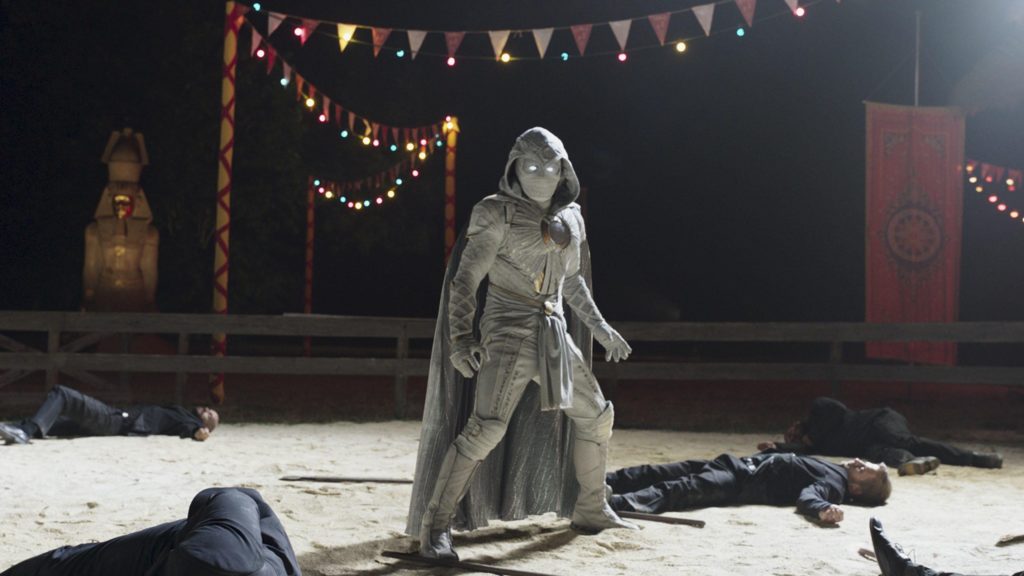
Luckily, The Bubble isn’t the only new thing that dropped last week. We also got a new Marvel series, Moon Knight. I’d say, of the five Marvel shows that have come out so far – Wandavision, Falcon and Winter Soldier, Hawkeye, Loki, and now this – it’s probably the most anticipated considering it has the best actor and the least known story. Unlike the other shows, Moon Knight is a brand new character we haven’t met before. It’s exciting having a complete unknown for once.
The thing I will give Marvel is that between Wandavision, Loki, and now this, they are taking chances. I can’t sit here and complain that Hollywood never takes risks then ignore it when they do.
I have a lot of admiration for Marvel using these shows as a testing ground for unique storytelling, and not just making them bite-sized versions of their movies. Well, I guess Hawkeye and Winter Soldier are bite-sized versions. But three of these shows are still unique. And Moon Knight may be the most unique of all.
At the center of the story is this giant mystery. This museum worker, Marc, constantly blacks out, missing huge chunks of his life, which results in a daily routine where he’s just trying to get up to speed half the time. For example, a female co-worker asks him if they’re still on for their date Friday night. Except Marc does not remember asking this girl out.
These missing chunks of time are getting more volatile, though. Marc will find himself in the middle of a small village in a completely different country surrounded by cult-members and have no idea how he got there. When they sense Marc is an intruder, they attack him, only for Marc to black out, and when he regains consciousness, 20 people around him have been violently killed, and his hands are dripping with blood. This cult leader, Arthur, wants something Marc has, an Egyptian gold scarab (our macguffin), and he’ll do anything to get it.
The pilot is a great reminder of how influential POV (point-of-view) is to a story. Take The Bubble, for instance. The POV was 20 different characters. We saw the unfolding drama through enough eyes to get a 10,000 feet high look at what was happening.
Here, the POV is just one person, Marc. And because we’re in his head with him when these chunks of time keep disappearing, we feel the same fear he does. I remember, at one point, literally wondering, “Good God. Is this what being crazy feels like? Where you’re a slave to this illogical sequence of events that are constantly changing?” I don’t have that feeling without Marc’s singular POV.
Imagine if Moon Knight was told like The Bubble, where we saw Marc’s situation through ten other people. All that fear would be gone. Cause we’d know exactly what was happening. So POV is something every writer should consider when writing a script. WHO has the POV and HOW MANY people have the POV will have a dramatic effect on character, plot, theme, how you build suspense, where you find your conflict, everything.
The question will be, can Moon Knight keep its death-defying pace up? Presumably, our main mystery will be solved going forward. They already kind of answer it at the end of this episode. So will they simply move the mystery over to his Egyptian roots and what this Arthur villain is after? Or will they just have Moon Knight solving crime, a la Batman?
It’d be a shame if that were the case but this has been my issue with the 6-8 episode format, in general. It’s not quite a TV show. It’s not quite a movie. So nobody really knows what to do with it. We’re in that experimental phase and, so far, I’m not sure I’d call the phase a success. The only high-profile show I’ve seen nail it so far has been Peacemaker.
But I’m rooting for Moon Knight. It’s probably one of the coolest superhero costumes I’ve ever seen. And who doesn’t want to see more Oscar Isaac? Have you seen either Moon Knight or The Bubble? Let me know what you think!
A storyline that got overlooked at the Oscars due to Slapgate was that Apple, not Netflix, took home the first ever Best Picture Oscar for a streaming service! You cannot begin to comprehend how angry this makes Reed Hastings, who has invested truckloads of money coveting high profile directors like Alfonso Cuarón and David Fincher, in hopes of winning that golden statue and legitimizing Netflix. I can only imagine how angry he is that streaming whipping boy, Apple, won their version of the space race.
I loved Sian Heder’s, Coda, and thought it was the perfect time to bring back the “scene breakdown” feature I did with “I Care A Lot.” I’m going to highlight two scenes from the award-winning script (which you can download here), and while the focus will be on dialogue, I’ll spotlight a few other screenplay tips as well.
If you haven’t seen Coda, it follows a senior in high school, Ruby, the only hearing member of an, otherwise, deaf family. While you’d think this would make her sympathetic to her parents and brother, it’s the opposite. She’s always been looked at as “the weird girl with the deaf family” and, as a result, felt ostracized.
For the first time ever, Ruby is doing something for herself. She’s always wanted to sing but hasn’t had the confidence to do so. So she’s joined the choir class in high school and the teacher has assigned her to a duet with Miles, a boy she has a crush on. The following scene takes place in their music teacher’s classroom. They were supposed to practice their song together but didn’t.


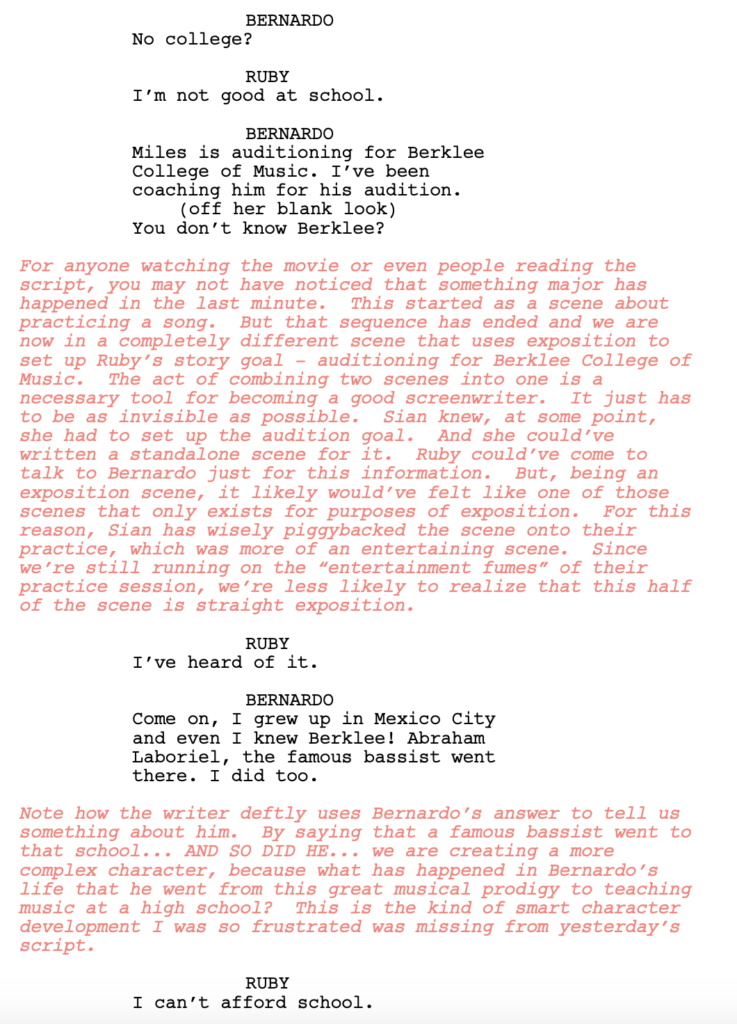
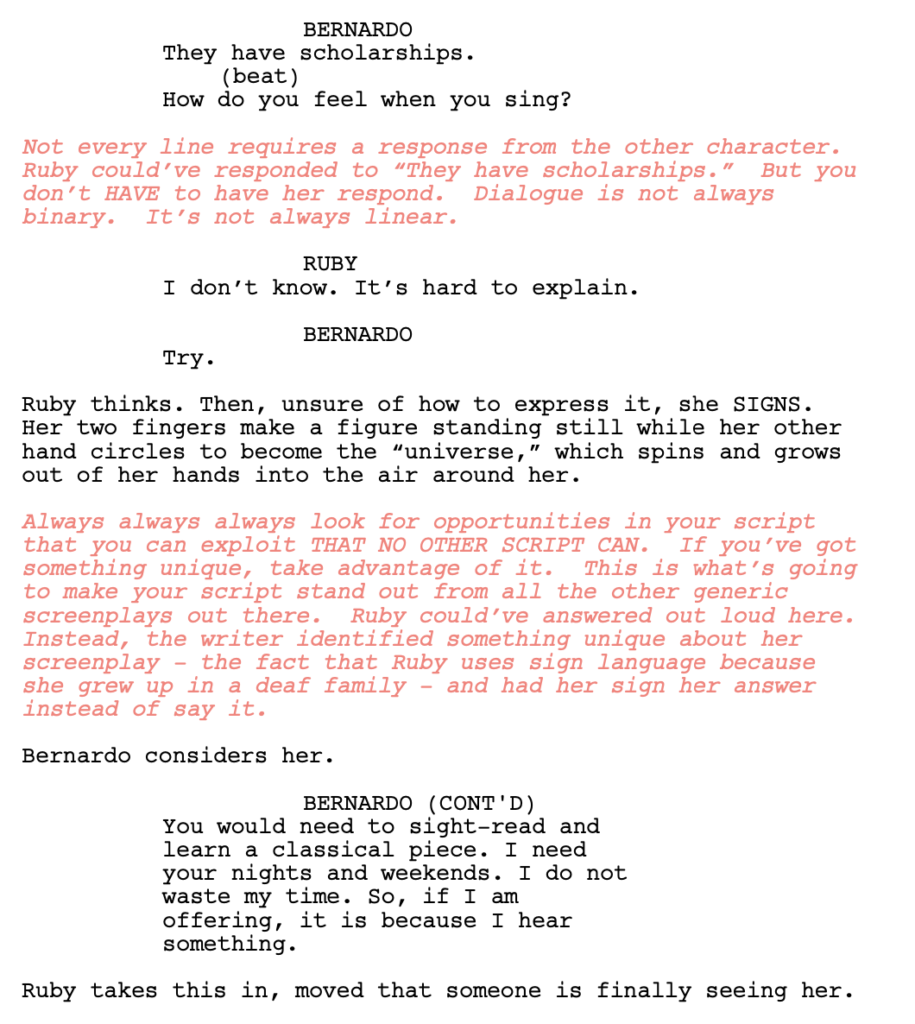
This next scene takes place 10-15 minutes later in the movie. This is the first time Ruby and Miles are practicing together and they’re doing so at Ruby’s house. Ruby is incredibly nervous about this not just because she has a crush on Miles, but because her family is such a wild card. She’s terrified that this may be a dealbreaker. I can’t stress this enough: Put your characters in situations they’re uncomfortable in. And with that established, let’s take a look at the scene…
And that’s it. I strongly recommend you read this script (it’s only 80 pages) AND watch the movie. Share your thoughts in the comments section, especially any additional lessons you picked up from the dialogue.

